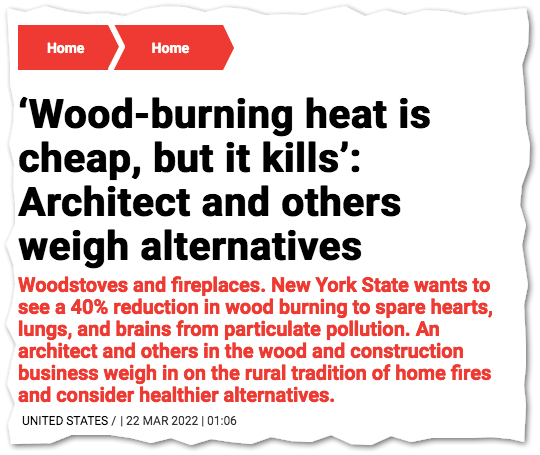I still surprise Passive House folk when I point out it’s better to use a heat pump than a wood burning fireplace for heating. It’s better for their clients’ health, their neighbours’ health and the planet. And yes, that is taking into account the carbon implications of the heat pump refrigerant.
The problem goes beyond the release of greenhouse gases as wood is converted to heat. If you can smell wood smoke, it’s a sign that you’re surrounded by a haze of tiny particles. (The largest, at 2.5 microns, is 30 times smaller than the width of a hair.) That fine particulate matter is bad for human health in a multitude of ways, some of which researchers are still discovering.
The New York State Climate Action Council Draft Scoping Plan (quoted here) lists an alarming array of “adverse health effects associated with exposure to wood smoke”, including of course asthma and cardiovascular events (stroke, heart attack, chest pain) but also dementia and Parkinsons. Prenatal exposure is also linked to increased rates of autism.
In New Zealand, your design can meet the Passive House PER (Primary Energy Renewable*) target with a wood stove or gas water heating but in general, not both. In countries like Australia where there’s less access to renewable power sources, specifying either will make it hard to meet your certification targets.
In most New Zealand climate zones, including a wood-burning fire in a certified Passive House home brings a considerable risk of overheating. I’ve heard feedback from a handful of projects where clients insisted on having them but found they don’t need them. Given the air-tightening complications a wood fire presents and the risk of backdrafting, I really don’t recommend it.
There are damn good reasons not to specify open flames for cooking either, which I covered off here.
* Refresher: PER (Primary Energy Renewable) is a way to judge how much storage is needed to allow a fully renewable energy supply for all of society. Australia’s winter supply of local renewable energy is more limited than ours. As a result, Australian buildings require more energy storage from summer to winter and have a more stringent PER target.

Comments 1
I found this very interesting, beginning to plan a small passive house but want to go off grid and was thinking a fire for cooking.